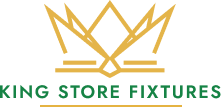Buying Guide for Racks and Fixtures
What you will learn
This store fixtures buying guide is specially designed to help retail store owners, retailers, and business managers understand the importance of the correct fixture placement to display their merchandise for proper visibility, practicality, and sales.
In this buying guide for racks and fixtures, we cover every aspect, from selecting a store fixture based on your products to qualifying retail display fixtures based on materials, durability, costs, branding, layouts, and installation.
We are going to answer all the burning questions you might have as your customers move through different stages of their buying journeys.
Buying guide for racks and fixtures - Introduction
Your customers quickly scan your entire store the moment they hit that decompression zone. And that is exactly your chance to capture their attention.
How you visually appeal your store with the correct fixtures and rack placement can directly impact your sales and customer experience. A study conducted by JBRMR supports this, highlighting how visual merchandising can significantly impact and boost store sales by 80% to 478%.
That’s some impressive numbers right there.
So, if you are in the middle of launching a new store or revamping your existing space, consider this.
Here’s your step-by-step retail display fixtures guide, starting from the basics, concluding with smart fixture choices, positioning, and a complete store layout to increase your customers’ shopping experience and boost your sales. It’s a win-win. Isn’t it?
What are store fixtures and racks?
What are store fixtures and racks?
A store fixture is a permanent or semi-permanent piece of equipment, furniture, or display unit used within a retail environment to present, organize, or promote products effectively.
Store fixtures are more like an in-store visibility strategy than just a piece of furniture or shelving, where your merchandise sits, allowing customers to see and interact with it.
Additionally, to give your store an organized look, enhance your store’s layout, and give your products maximum visibility, use a smart placement strategy for your fixtures.
In case you aren’t familiar with the term “store fixtures”, they’re also known as retail display furniture, merchandising displays, shop fittings, or in-store display units.
Racks
Racks, on the other hand, are structures designed to hold, hang, or display products.
Racks are also store fixtures that help stores create a visual merchandising experience that guides customers from the decompression zone and invites them into the store.
The more effortless you make this experience by ensuring customers do not have to try too hard to get their hands on the product, the more likely they are to engage and ultimately make a purchase.
Types of Store Fixtures & Racks
This store fixtures buying guide will discuss multiple types of store fixtures. Why is it important to understand this? Because fixtures are not universal. You can’t find one perfect fixture that works for every store.
Also, based on your product, store layout, customer preferences, and budget, you can choose the fixture that aligns with your needs instead.
Gondola Shelving
This is a freestanding shelving unit often used in supermarkets. Gondola shelving displays are highly customizable, adaptable, and affordable. They support various merchandising options and help stores maximize their floor space utilization.
They can be modified with accessories to showcase hot-selling or newly launched products and are easily branded with signage.
Types include:
- Large islands
- Small point-of-sale (POS) displays
- End cap gondolas (perfect for promotions)
Gondola units can also be designed as island units with lockable wheels for easy repositioning.
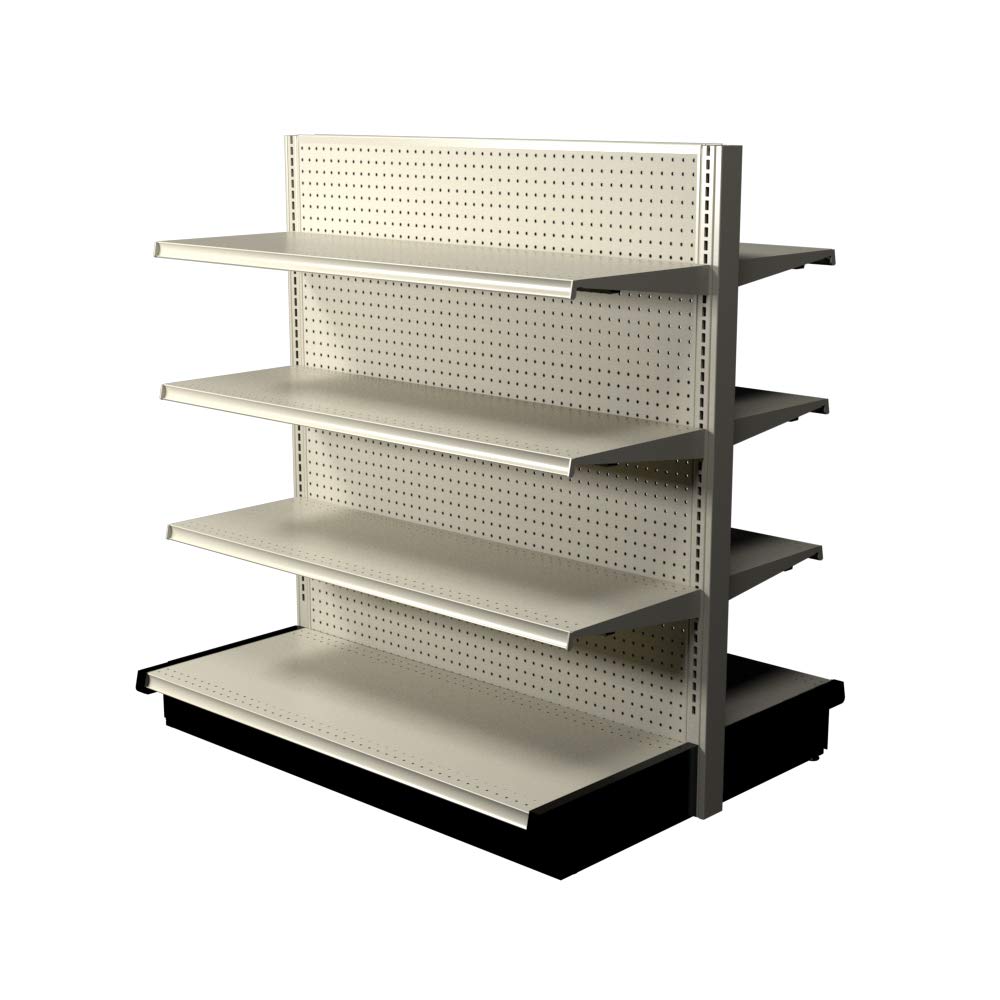
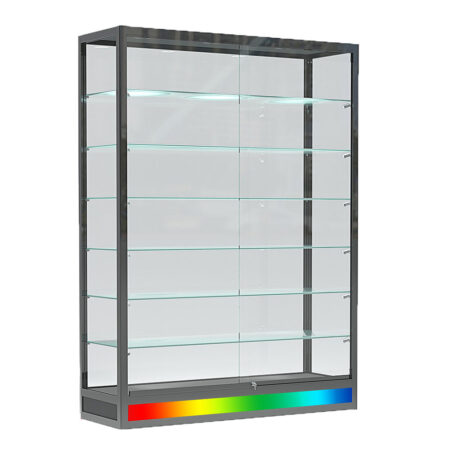
Wall-Mounted Racks
Wall-mounted racks, also known as wall display racks, are fixtures attached to walls for smart space use.
For example, slatwall and gridwall are ideal for displaying multiple products without occupying too much floor space and cluttering. Also, they are great for small stores with limited floor space.
Freestanding Racks
These are mobile or standalone racks, not fixed to walls. They are easy to move and reposition, making them suitable for large stores or those with changing layouts. These types of racks are easily customizable to better align with your store design.
Like clothing racks or jewellery racks that are easy to move, can be customized, and are great for displaying promotional items or newly launched products.
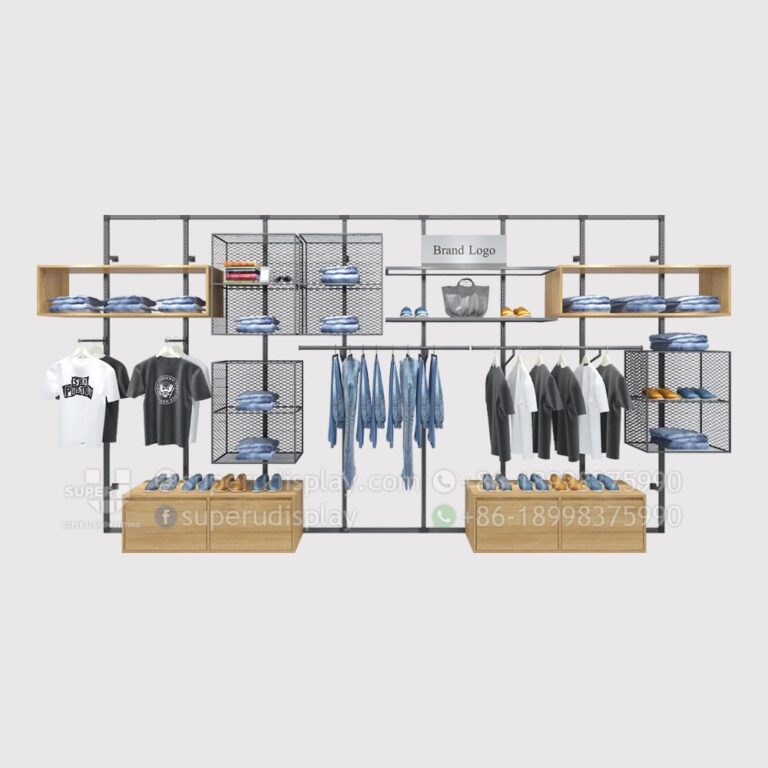
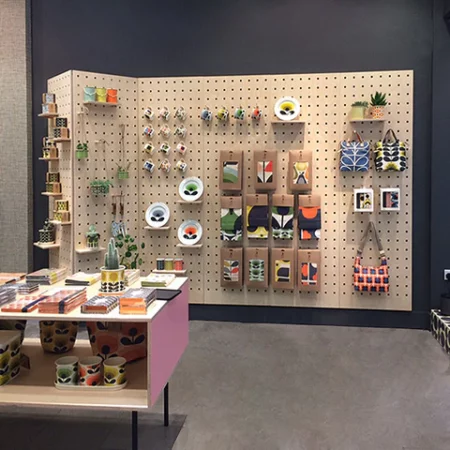
Pegboards
We all have seen those perforated boards hanging on walls. These multi-purpose boards are highly efficient when it comes to holding hooks for product display.
While less durable than gridwall or slatwall, pegboards offer a simple, functional solution for displaying products.
Moreover, the basic and primary design is limited to peg hooks. But this simplicity makes them an affordable and straightforward option for organizing lighter items.
Slatwall Panels
These are wall panels with horizontal grooves from which shelves or hooks can be hung for adjustable shelving.
Unlike pegboards, slatwalls offer multiple accessory options and are much sturdier, more durable, and add a sleek look to your store.
Also, these walls are multi-purpose and highly flexible for displaying merchandise, allowing you to refresh products every now and then with different styles and layouts.
They are widely used in retail stores, electronics, and decor, and can be configured as pinwheels, four-sided towers, freestanding units, or end-of-aisle displays.
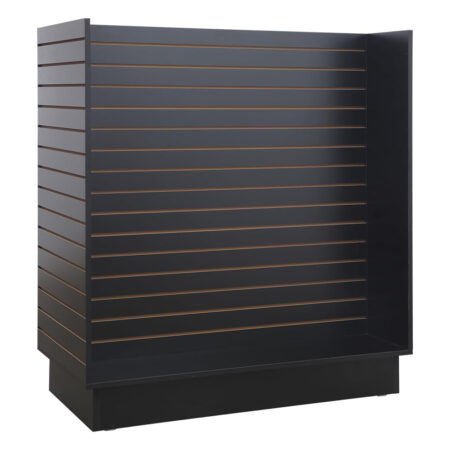
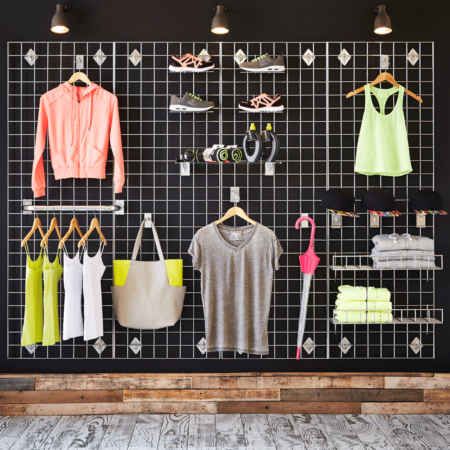
Gridwall Systems
Gridwall systems are again multi-purpose fixtures composed of metal wire grids. You can use these grids to create highly flexible display configurations using hooks, shelves, mount brackets, or baskets.
Gridwall systems are economical, durable, easy to install, and can be adjusted without covering a large floor space. You can attach them to the wall or use them as mid-floor display stands.
Depending on what makes it easier for your customers to discover your products and enjoy a smooth store experience.
End Caps
Just like it sounds, end caps are display store fixtures usually found at the end of an aisle. These fixtures are often used to display products that are either hot-selling, on sale, or impulse goods.
With the end of your aisle capped, they give the store overall visual appeal while taking up limited floor space.
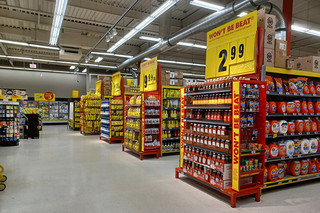
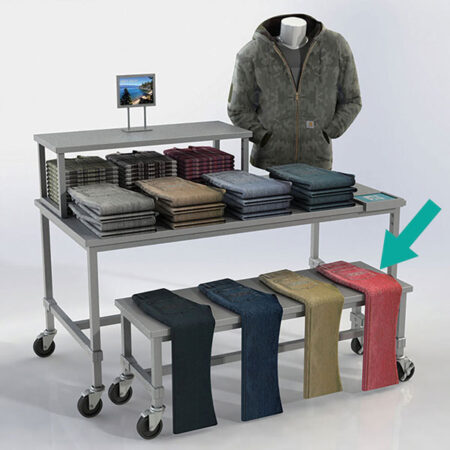
Nesting Tables
Nesting tables are stackable retail tables often used to display folded merchandise, mid-store displays, or found in waiting lounges.
These tables give a sleek and modern look to your store while saving enough space for customer flow.
Round Racks & Straight Racks
Round racks are circular clothing racks that hold a sizeable number of garments. Meanwhile, straight racks are linear garment racks that are easily movable and provide maximum product visibility and easy access.
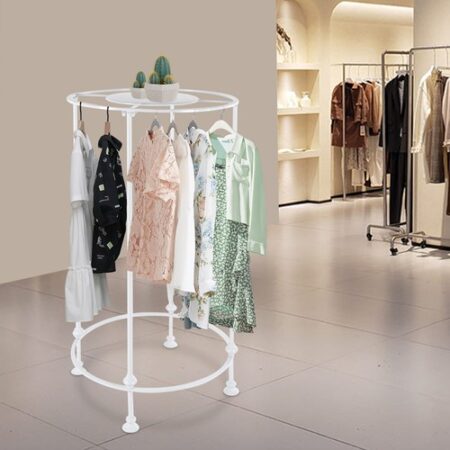
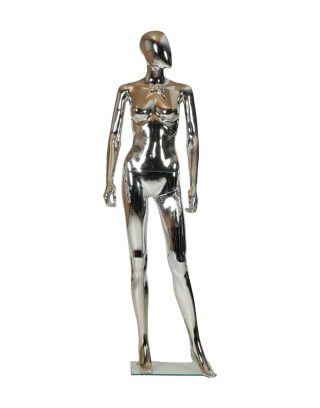
Display Mannequins
To give your customers a realistic view of how these clothes will look on them, stores use display mannequins, human-form figures, to showcase clothing.
There are different types of mannequins available, like full body forms, a part of the body, or only a half body form, based on the product type.
For example, if you sell jewelry, you might need only hand or neck displays to showcase your products.
Wire Shelving
Wire shelving is a metal display fixture usually found in warehouses and supermarkets to store and hold heavy loads/large amounts of products.
These wire shelves are in high demand because of their attributes like sturdiness, durability, and ease of cleaning.
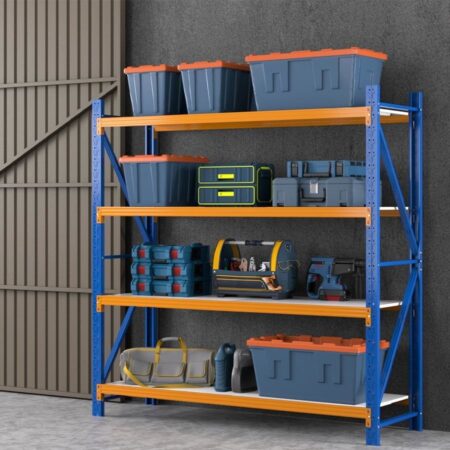
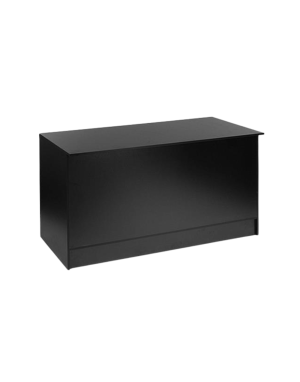
Wooden Shelving
If you want to give a luxurious and premium look to your retail store, go for wooden shelving. High-quality wood makes these fixtures highly durable, though they still require polishing and maintenance to look their best.
Acrylic Displays
Transparent and versatile, acrylic displays come in many configurations to showcase a wide range of products.
These glass fixtures are fragile, prone to scratching, and breakable. Moreover, extra precautions should be taken to avoid damaging these fixtures.
Besides that, these displays give a sleek, premium, and modern look to your store. They come in acrylic boxes, wall-mounted racks, or shelves that offer floating or stacked display options.
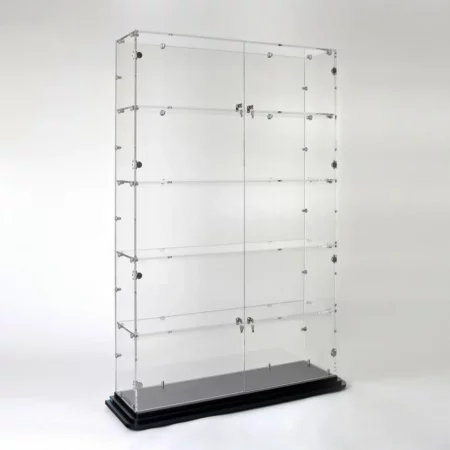
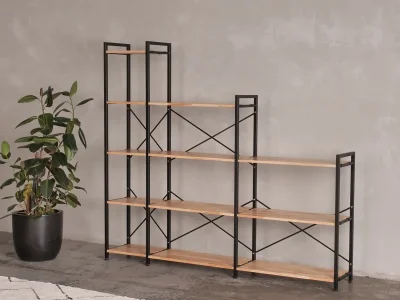
Modular Shelving
Modular shelving is a versatile solution for displaying products. Using gridwalls or slatwalls, you can easily reconfigure your display to match different themes or new stock. Arranging your shelving effectively can help you avoid buying additional fixtures.
What to consider before buying store fixtures?
Now, we have ample understanding of the different types of store fixtures available in the market. Let’s find out all the major factors that play an important role in selecting the right display fixture for your store.
Durability & material
What products are you selling? This speaks a lot about the type of material you should use for your store fixtures.
Look for durable, sturdy, and high-quality material that can withstand daily customer interaction in busy retail environments, because the material you choose directly impacts the lifespan of your fixtures.
Usually, there are four types of materials used to build fixtures, including metal, wood, plastic, and acrylic.
Metal fixtures offer extra support, sturdiness, and long-lasting durability. So, this is the best choice for an industry-theme setting requiring the display of heavy products.
But, if you want to give a premium, warm, and subtle look to your store, choose fixtures made with hardwood that give a sleek look to your store and are also durable.
Meanwhile, acrylic/plastic are lightweight and transparent materials that increase product visibility. Stores that deal in jewelry/accessories or clothing often use acrylic boxes, shelves, or racks to display their products, which offer protection and appeal to the customer.
Other materials include glass (for high-end showcases), MDF, and particleboard. We suggest you invest in quality materials from the start because it will save you a significant amount of cost that you might otherwise spend on repairing or replacing low-quality fixtures.
Safety and load capacity
Choose fixtures that can endure the weight of your product. Check for stability – whether the fixture is stable enough to prevent any tripping hazards.
For example, if your products are heavy, you can go for heavy-duty racks made of steel, which provide maximum stability and can hold heavy loads while protecting customer flow during busy hours.
Also, check if the fixture you choose aligns with the safety standards and regulations issued by the government to prevent both employees and customers from injury. Some of the standards include:
Regulation | What is it for | What it covers |
OSHA 29 CFR 1910 | Safety requirements for walking/working surfaces, materials handling, and storage | Covers the stability of fixtures, the prevention of tripping hazards, safe display heights, and placement |
ANSI/BIFMA Standards | Safety and performance standards for commercial furniture | Applies to shelving, tables, racks, and modular fixtures used in retail – checks load-bearing, tip-over resistance, and structural integrity |
ANSI/NFPA 101 – Life Safety Code | Fire safety and emergency egress requirements | Ensures fixtures don’t block exits, aisles remain clear, and materials meet fire ratings |
ADA (Americans with Disabilities Act) | Accessibility requirements for public spaces | Defines aisle width, reach range, and fixture height so all customers (including wheelchair users) can shop safely and comfortably |
If the product meets the majority of the standards and is made with safety and regulatory compliance in mind, go for it.
Branding
Branding creates association!
Customers associate your brand with its colors, and your store gives visual identity to your brand. Therefore, the fixtures you choose must align with that visual language. To achieve this, you should opt for custom options where you can select the logo, color, design, and style of your fixtures to match the aesthetics of your store. That’s how, with the right fixtures, you can give your customers a memorable shopping experience.
Portability and flexibility
Retail stores have rotational inventory, right? Every few months, you are adding new products. Therefore, for the fixture option, go for ones that are multi-purpose, flexible, and adjustable, like modular shelving, slatwalls, gridwall systems, etc.
These fixtures allow for easy rearrangement and can be relocated to adapt to changing needs. And the most exciting part is, you won’t need new fixtures every few months.
Therefore, go for modular, mobile, and adjustable options that align with your products and store layout.
Cost vs. value
Before choosing any fixtures, factor in all the costs and ROI. Seek answers to questions like:
- How much can you endure if the fixture wears down quickly during rush hours?
- How much are you willing to pay for the monthly or yearly maintenance of the fixtures?
- Or how many sales can you drive by investing in high-quality fixtures that offer maximum durability and visibility?
Once you write down all the questions that could cost you a fortune just by going for cheap material fixtures, you will ultimately understand the importance of high-quality and premium fixtures.
The investment you make once in quality can save you years of maintenance, repair, and replacement costs.
Space and layout
Your customers don’t care how small or large your store is – they care about how easy you make it for them to navigate between aisles or racks and how easy you make it to find what they are looking for.
Therefore, depending on your store layout, choose fixtures that provide maximum floor space and visibility into products. The smoother the customer experience is, the higher the sales you will generate.
For example, if you have a small store with a horizontal layout, instead of going for large mid-floor gondolas or racks, use slatwalls/gridwalls, modular shelving, or wire shelving that takes up limited floor space and also makes it easy for the customer to find what they are looking for.
On the other hand, if you own a large store, then you have multiple layout options that add space and visibility, along with easy navigation.
Sustainability
If you deal in sustainable products, then going for eco-friendly fixtures will perfectly align with your mission. Look for fixtures made with recycled materials that also comply with sustainability certifications.
How to choose the right fixture for products?
Your store layout, design, and strategic fixture placement encourage customers to move from the decompression zones to the product sections. And that’s how a simple layout can considerably impact your customer flow, journey, and purchasing decisions.
How do fixtures affect customer flow?
How well you manage your customer flow determines a lot about your customer experience. Simply observing how customers move through your store helps with smart fixture placement. If you notice that a certain fixture is blocking movement or that another is attracting the majority of eyeballs, rearranging the fixtures or refreshing the store layout will help you engage more customers. Your goal is to arrange the fixtures in a manner that avoids overcrowding, maximizes floor space, and prevents accidents during rush hours.
Wall-mounted vs. freestanding racks
Again, based on your store layout, you can choose from two types of racks most commonly used in the majority of industries.
Wall-mounted racks are permanently drilled into the walls (not movable). Small stores commonly use these racks to save floor space.
The other ones are freestanding racks that are movable, require no installation, and take up floor space. These types of racks are usually seen in large stores.
Mobile vs. stationary
Mobile fixtures have wheels and can be relocated depending on the need, while stationary fixtures are fixed and more stable. You can use both based on the products you choose to display.
Moving racks are great for showcasing promotional products at the point where you believe they will catch the most eyes, while stationary options are best for regular products.
Avoiding overcrowding
The purpose of fixtures is to represent your products in the best possible way so they appeal to customers.
But, avoid overcrowding your store with fixtures as it may overwhelm customers. Therefore, only use fixtures that enhance the store layout, not hinder the experience.
Fixtures for seasonal products
Use movable or temporary fixtures for seasonal products or if you rotate your stock often. This way, you can place them in the best locations. Modular racks are great for this, as they are easy to configure, move, and easily align with your store’s theme and layout.
Budget and Cost Planning
Now we have come to the most important part – cost planning and budgeting, which is considered the backbone of overall business planning. Deciding how much budget you should allocate or invest in store fixtures depends on:
- Whether the initial cost balances the long-term value of the fixture chosen
- And how much operational efficiency it will bring
Now, let’s consider the factors that contribute to overall cost planning.
Average price ranges for different fixture types
The cost of fixtures varies based on the material you choose, the quality of the material, and the type of fixture you consider. Therefore, vet the suppliers thoroughly before buying any.
Look at the requirements you have and whether they match the product the vendor offers. What are the price variations between vendors, and which one is offering the best deal? Based on your budget, select the vendor and further discuss the terms.
Bulk purchase benefits
If you are a regional or national chain that needs bulk fixtures with proper branding, then you can enjoy various benefits on your large orders.
When you order in large quantities, the cost per unit drops, and manufacturers offer good discounts and deals like lower shipping expenses and shorter lead times.
Leasing vs buying
If you have just started your retail business and don’t have the capital to invest in buying fixtures, then you can go with renting and leasing options, where you can get ready-to-use fixtures.
But if you want to create a thorough experience for your customers with established branding, then go with buying your own fixtures with branding to create brand association.
When to invest in heavy-duty vs light-duty?
Heavy-duty fixtures are those that can carry heavy loads and are made with sturdy materials like metal. These fixtures are costly but best for warehouses and supermarkets that need steady fixtures that can endure heavy customer flow and interactions daily.
Light-duty fixtures are the ones we see in various retail stores. They can carry medium to low load capacity and are made of metal, wood, plastic, or acrylic. If your products fall in the medium to low range, then these are the best options for you.
Hidden Costs
While we heavily focus on visible costs like the cost of the fixture itself, we often overlook hidden costs such as shipping, warehousing, distribution fees (especially for large-scale projects), installation labor, potential repairs, and long-term maintenance.
Therefore, when you ask for quotes from manufacturers, ask them to give a detailed breakdown with all costs included to prevent last-minute revenue leakage.
Installation and maintenance
Proper installation and regular maintenance are crucial for the longevity of your fixtures.
Assembly process
When you buy a fixture, ask if it comes flat-packed or pre-built. Most fixtures come flat-packed and need assembly once they reach the destination.
Therefore, don’t try to build the fixture yourself. Instead, consult a professional for help. Most vendors send their specialists along with the delivery for proper installation.
Also, if the vendor doesn’t provide this service, you can hire a private installation technician to assemble the fixtures safely, avoiding delays and preventing mistakes/ accidents.
How to maintain and clean fixtures
Establish a cleaning routine from the very start. Choose fixtures made of materials that are easy to clean and have removable components.
In the long run, a proper cleaning and maintenance routine increases the lifespan of your fixtures and gives a fresh look every time a customer enters your store.
Reuse, replace, and upgrade cycle
As discussed earlier, investing in high-quality materials saves you a lot of maintenance, repair, and replacement costs. High-quality materials provide longevity to your fixtures, reducing the need for frequent upgrade cycles.
What are the key mistakes to avoid when buying fixtures?
Choosing fixtures that don’t match the brand
What differentiates a brand from a simple business? Smart branding. Your store is a visual imprint of your brand. Don’t go for random and generic fixtures that create an imbalance.
Go for custom options with branding to create a cohesive look throughout the store. It positively impacts customer experience and links your brand’s specific colors, emotions, and designs to the customer’s mind, creating a strong bond.
Misjudging space
Before ordering a fixture, first map your floor plan and consider all possible areas where displays can get maximum advantage in terms of visibility and purchasing.
Otherwise, you may end up with large fixtures that overcrowd your floor space or fixtures that are too small and go unnoticed. Always consider your space before choosing any option.
Buying cheap fixtures that don’t last
If you are planning to go for a cheaper option just to save some cost, stop right there! A cheap fixture may initially save you money, but in the long run, you will end up spending more on repairs, maintenance, and replacements.
Therefore, avoid buying fixtures that are easily prone to errors and can cause accidents during heavy customer interaction, such as breaking or tripping.
Poor layout planning
Just like you manage your space, consider the layout of your store too. Match the layout with the fixture type to have maximum floor space. An aesthetic store doesn’t need more fixtures. Rather, it needs a plan that identifies which display fixtures work best in specific locations.
If you have a large store and only install wall-mounted fixtures, it becomes difficult for customers to navigate and find what they are looking for.
But if you manage the layout and add aisles, gondolas, and moving racks with promotional products, it gives customers a proper shopping experience. Always make it easy for them.
What next?
Well, you have reached the end of the buying guide for racks and fixtures, and congratulations, now you are ready to buy the ideal fixtures for your store.
Wait!!
If you are wondering where to start and where you can find affordable, customizable, and high-quality store fixtures, we won’t let go of your hand.
At King Fixtures, you can find premium-quality store display fixtures. Browse through the list of fixtures that come in various types, styles, and materials. You can choose the one that perfectly aligns with your requirements.
